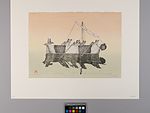Umiak
About this object
History of use
Contemporary Inuit prints were first produced at Cape Dorset in 1957. Although precursors to printmaking can be seen in women's skin applique work and in men's incising of ivory, stone and bone, the impetus for printmaking was as a commercial venture. This venture was established jointly by Inuit artists and John Houston, the civil administrator for Cape Dorset. Other Inuit communities quickly followed the commercial success of Cape Dorset's West Baffin Eskimo Cooperative. Printmaking developed as a communal activity following a Japanese, rather than a Western, model of serigraph production. Each year the cooperatives produce a series of limited edition prints which are sold in the retail art market. In 1965, the Canadian Eskimo Arts Council was established from the Canadian Eskimo Art Committee to ensure high standards were maintained. Printmaking, along with stone carving, provide cash income for communities which have undergone rapid and significant change, during the late 20th century, from traditional hunting based societies to settled communities dependent on consumer goods. The prevalent images depicted in Inuit art are of traditional life, arctic animals and mythology. Recently, contemporary subjects have been depicted by a minority of artists.
Cultural context
contemporary art
Physical description
Boat with a mast and a furled sail. Four rowers and one helmsman are inside the boat. The sky is shades of pink-orange to yellow at the horizon line, and the water is light green. The boat is reflected in the water with slight distortion. The name of the printmaker is printed in Inuit syllabics along with the Cape Dorset stylized red igloo seal in the lower left-hand corner. At the bottom of the image is written, "Umiak Lithograph 33/60 Dorset 1979 Kananginak," and the name of the artist is written in Inuit syllabics. The Canadian Eskimo Arts Council and Cape Dorset Cooperative blind embossed stamps are in the lower right-hand corner.
Categories
